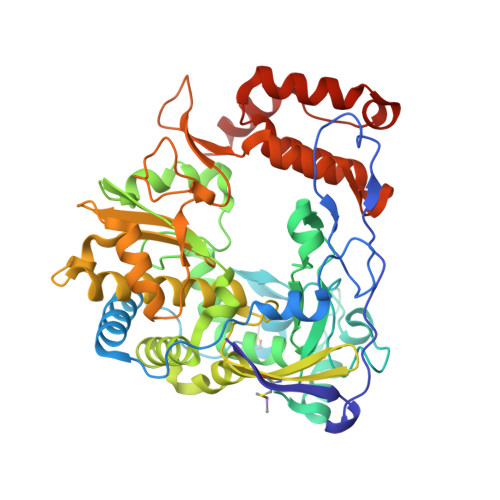Distinct conformations of a putative translocation element in poliovirus polymerase.
Sholders, A.J., Peersen, O.B.(2014) J Mol Biol 426: 1407-1419
- PubMed: 24424421
- DOI: https://doi.org/10.1016/j.jmb.2013.12.031
- Primary Citation of Related Structures:
4NLO, 4NLP, 4NLQ, 4NLR, 4NLS, 4NLT, 4NLU, 4NLV, 4NLW, 4NLX, 4NLY - PubMed Abstract:
The mechanism whereby RNA is translocated by the single subunit viral RNA-dependent RNA polymerases is not yet understood. These enzymes lack homologs of the "O-helix" structures and associated fingers domain movements thought to be responsible for translocation in many DNA-templated polymerases. The structures of multiple picornavirus polymerase elongation complexes suggest that these enzymes use a different molecular mechanism where translocation is not strongly coupled to the opening of the active site following catalysis. Here we present the 2.0- to 2.6-Å-resolution crystal structures and biochemical data for 12 poliovirus polymerase mutants that together show how proper enzyme functions and translocation activity requires conformational flexibility of a loop sequence in the palm domain B-motif. Within the loop, the Ser288-Gly289-Cys290 sequence is shown to play a major role in the catalytic cycle based on RNA binding, processive elongation activity, and single nucleotide incorporation assays. The structures show that Ser288 forms a key hydrogen bond with Asp238, the backbone flexibility of Gly289 is required for translocation competency, and Cys290 modulates the overall elongation activity of the enzyme. Some conformations of the loop represent likely intermediates on the way to forming the catalytically competent closed active site, while others are consistent with a role in promoting translocation of the nascent base pair out of the active site. The loop structure and key residues surrounding it are highly conserved, suggesting that the structural dynamics we observe in poliovirus 3D(pol) are a common feature of viral RNA-dependent RNA polymerases.
Organizational Affiliation:
Department of Biochemistry and Molecular Biology, Colorado State University, Fort Collins, CO 80523-1870, USA.


















